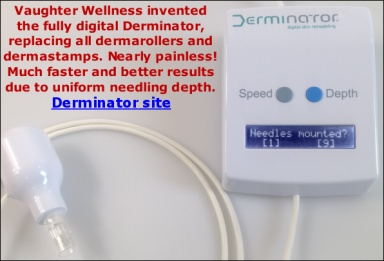>My question is about ReCell, a new spray-on skin treatment by Avita
>Medical that uses the patient's own skin. It is supposed to help improve
>skin texture. Unfortunately, it must be used after a procedure that injures
>the skin, such as dermabrasion or laser. I do not wish to undergo those
>procedures. Do you think the ReCell treatment could be beneficial if
>applied after and agressive needle-rolling session? And do you have any
>thoughts about ReCell?
The ReCell method is based on removing a small piece of epidermis (below the ear). The Epidermis is the outermost skin layer and it is only about 0.1- 0.3 mm thick.
The removed epidermis is processed to separate the cells and a suspension (a fluid containing solid particles) is made. It contains epidermal cells - keratinocytes, melanocytes, fibroblasts and Langerhans cells.
The suspension is applied to unhealed injuries, especially to burns. It speeds up re-epithelization of the injury. The quicker an injury heals, the greater the likelihood that it heals with a scar that is not hypertrophic.
ReCell is also used to re-pigment hypopigmented areas.
Various methods of melanocyte (cells producing skin pigment melanin) transfer have already been successfully used for a long time for Vitiligo. The epidermis from a normally-pigmented area is removed/scratched off, then processed (or not) and applied on the area with hypopigmentation that had been abraded beforehand, to enable the "uptake" of the applied melanocytes.
It is an interesting method, however it is still risky and complicated. Needling/dermarolling is incomparably easier and it actually triggers melanocyte production. Furthermore, needling the hypopigmented area, including needling slightly outside of its borders will enable a rapid migration of the melanocytes from the surrounding normal skin into the hypo-pigmented areas. We have many customers who permanently fixed their hypopigmentations with needling.
Concerning your question: Applying ReCell after dermarolling/needling would likely allow the applied cells to penetrate and be "taken". However, there is no need for speeding up the healing time after dermarolling because healing is already extremely fast due to the fact that dermarolling does not remove the epidermis. It merely pricks it. There are small microinjuries from the needles but these heal rapidly.
Dermarolling triggers production of all the cells that are in the epidermal suspension thus I do not think you will benefit applying it. It will certainly not make the pores smaller or smooth out the skin texture.
ReCell is very beneficial for quick re-epithelization of an injury or any other case where quick epitheization is helpful – for example, after abrading a hypertrophic burn scar, after skin transplants, after a very deep acid peel, after ablative laser resurfacing etc. It will speed up the healing time and thus prevent potential problems, such as infection, scarring etc.





